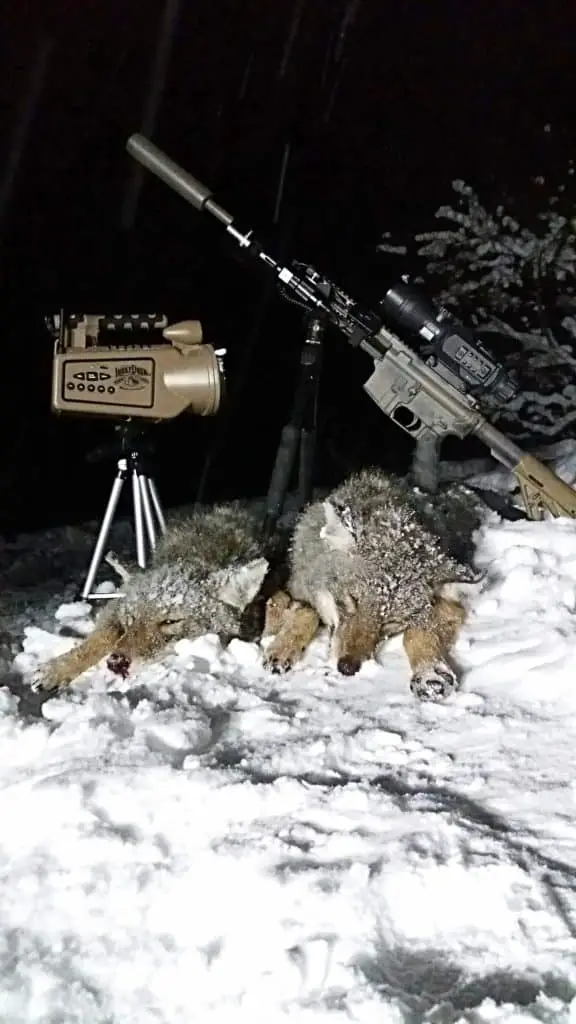Determining your distance between stands when coyote hunting is easy. There are only four factors to consider. When you add up all four, you get the secret to how far apart your coyote stands should be.
The four factors determining the distance between stands
Before we begin, toss out the adage of “1 to 2 miles for western coyotes and 500 yards for eastern coyotes.” In a few minutes, you’ll be able to nail down the precise distance between stands with much greater accuracy.
The four factors you need to consider are; the current season, time of day, weather, and terrain.
Two of these (season and time of day) are important, two of them (weather and terrain) are critical.

Coyote season effects your distance between coyote stands.
The season you are coyote hunting dictates how far coyotes usually are traveling.
More coyotes travel and cover greater distances during pup dispersal and mating season. With coyotes running all over the map searching for new territories to claim and mates to breed with, you can shorten your travel distance between stands to a minimum.
During denning and pup rearing season, paired Alphas (mom and dad) spend their time close to their dens and pups. Travel for the male is limited, but the female is remains locked in a prison cell made of dirt.
When coyotes have such restricted daily ranges, you’ll need to increase how far apart you make your stands. Your goal is to get your caller playing sounds in a different coyote’s territory.
The rule of thumb: The more the coyotes travel, the less you have to travel.
Related: For some great tips on predator hunting, check out Predator Hunting 101.
The time of day you are coyote hunting.
Like it or not, coyote researchers have proven beyond a doubt; coyotes are much more active during the darkest hours of the night.
Related: https://thepredatorhunter.com/the-absolute-best-hours-for-hunting-eastern-coyotes/
During the day, coyotes spend much of their time bedded down. As a result, they resist the urge to investigate even the most pleasing sounds, especially if they are far off in the distance. You’ll need to significantly increase your distance between stands to overcome their resistance and gain the attention of more and different ears.
In the middle of the night, nearly 80% of the coyote population is on the move, depending on the season. As a result, hunting coyotes travel vast distances. On the other hand, you can decrease how far apart you make your stands.
Terrain and how far apart to set your stands when coyote hunting.
The terrain has two effects on coyote hunting; it limits the size of a coyote’s territory and limits how far the sound of your caller travels.
Wide-open terrain and the need to travel greater distances when hunting increases the size of a coyote’s territory. Unfortunately for you, this drastically limits the number of coyotes and increases the length you’ll need to move between stands.
Rough terrain (hills, ridges, valleys, and thick vegetation) leads to smaller coyote territories. This is especially true with the famed eastern coyote.
Rough terrain also reflects and absorbs your caller’s sound. If you only have one large property to hunt, this is a feature rather than a bug. Feel free to limit your travel between stands to almost as little as you’ll move them for the next factor.
Wind, the most crucial factor for distance between stands.
The wind is the single most crucial factor for determining your distance between stands for one reason; it controls how far your sounds travel.
It’s a simple equation: the farther your calls carry, the more ears that will hear it.
A good e-caller will pump out quality sound over a mile if the winds are dead calm. However, on windless days, it’s a trade-off. You reach all the coyotes within that mile, but you have to separate your stands by at least a mile to reach new ears.
Please note: If you use a link I provide, I may get a small commission at no extra charge to you.
However, once the winds hit 15 mph, that distance drops almost 25%. At speeds over 25 mph, coyotes more than 1/3 of a mile away will never hear it. So again, it’s a trade-off. Less carrying distance for your caller’s sounds, but your travel between stands can also be reduced.
Related: https://thepredatorhunter.com/the-truth-about-predator-hunting-in-bad-weather/
Add them all up, and you have the perfect distance between stands.
Sure, the time of day and coyote season your hunting help you pick the peak activity time for coyote movement. That’s important. And the terrain and wind you are coyote hunting in absolutely determine how many coyotes will hear your caller.
But all four combined provide you with one of the most valuable tools you will ever have in your coyote hunting toolkit—the knowledge of how much distance between stands you’ll need on any given day.
Add them all up, and you’ll call more coyotes in every single time you make a stand.

